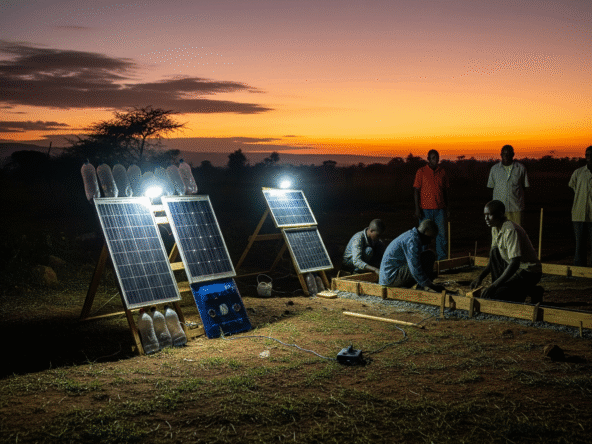As Kenya’s housing market matures, more developers and homebuyers are turning toward modern construction techniques that promise long-term value, energy savings, and structural integrity. Among these, cavity wall construction is emerging as a top choice, especially in master-planned estates, semi-urban towns, and climate-sensitive areas.
If you’re exploring budget-friendly housing, managing your own construction, or investing in a fixer-upper, understanding the full potential of cavity walls could significantly influence your project’s outcome.
What Is a Cavity Wall?
A cavity wall is a dual-layered masonry structure made up of two parallel walls commonly referred to as the inner and outer leaves separated by a hollow space or “cavity.” These two walls are connected by wall ties at regular intervals to provide structural stability.
The cavity itself isn’t just empty space it plays a functional role in thermal insulation, moisture resistance, and sound dampening.
In many modern Kenyan homes—like those featured in Modern Houses in Kenya Worth KSh 3 Million or Less cavity walls are increasingly being adopted to meet sustainability and comfort benchmarks.
Key Benefits of Cavity Walls
1. Thermal Performance
The cavity acts as a thermal buffer zone. It limits heat transfer between the internal space and outside environment, keeping homes cooler in hot climates and warmer during colder months. For energy-conscious buyers, this means reduced reliance on air conditioning and heating.
2. Protection from Rain and Moisture
In high-rainfall zones like Limuru, Nyeri, or Kikuyu, moisture can seep through single walls. Cavity walls stop this by channeling water down the cavity and away from the interior—an important feature for buyers of Affordable Agricultural Plots Under KSh 1 Million looking to build in cooler, wetter areas.
3. Noise Reduction
Double-layered walls separated by a cavity help to block out external noise. This is particularly useful in areas near major highways or growing urban centers like Utawala, highlighted in Utawala on the Rise.
4. Structural Longevity and Fire Resistance
When built with quality materials and proper detailing—including cavity barriers—these walls resist decay and offer better fire containment than single-wall systems.
Construction Process in Kenya
Constructing a cavity wall involves precision and skilled labor. Here’s how it’s done locally:
- Foundation Layout: Requires a broader base to support the added width of dual walls
- Wall Ties: Placed at 450mm vertically and 900mm horizontally, using galvanized or stainless steel ties to bind the two layers
- Insulation Material: Rigid foam boards or mineral wool are inserted to improve energy performance
- Damp-Proof Courses (DPCs): Installed at the base and window levels to stop rising damp
- Weep Holes: Built into the outer wall to allow water trapped in the cavity to drain out
These practices are now being adopted even in mid-range developments by contractors such as those featured in Why Hiring a Granite Construction Company Is the Smartest Move for Your Next Project.
Construction Standards and Compliance
For proper cavity wall implementation, adherence to both local and international construction standards is critical:
- ACI 117: Governs tolerances in concrete work, ensuring alignment of internal and external wall faces
- CSI MasterFormat: Offers a detailed classification system cavity walls fall under Divisions 04 (Masonry) and 07 (Thermal & Moisture Protection)
- Kenyan Building Codes: Increasingly include requirements for DPCs, cavity spacing, and structural ties—particularly in multi-storey or commercial housing developments
Such regulations are especially relevant when building in peri-urban satellite towns, where zoning and infrastructure are rapidly evolving.
Where and When to Use Cavity Walls
| Application Zone | Suitability |
|---|---|
| High-altitude or rainy regions (e.g. Limuru, Nyandarua) | ✅ Excellent |
| Urban centers with high noise exposure | ✅ Recommended |
| Eco-friendly estates and smart homes | ✅ Strategic |
| Hot, dry rural zones (e.g. parts of Machakos or Turkana) | ⚠️ May not justify cost |
For renovators working on older buildings—like those explored in From Fixer-Uppers to First Homes—cavity wall retrofits are becoming a valuable upgrade for both performance and resale.
Cavity vs. Solid Wall Comparison
| Feature | Cavity Wall | Solid Wall |
|---|---|---|
| Thermal Regulation | High | Low to Moderate |
| Water Resistance | Excellent | Poor |
| Initial Cost | Higher | Lower |
| Resale Value | Strong ROI | Location-dependent |
| Maintenance | Low | Higher over time |
When comparing Houses Below 1 Million, consider that homes with solid walls might appear cheaper upfront, but cavity-walled homes offer lower utility bills and better structural performance over time.
Return on Investment (ROI) Potential
Homes built with cavity walls tend to retain their value, require less repair, and are more attractive to buyers and tenants seeking comfort and efficiency. These ROI benefits are consistent with those seen in House Flipping in Kenya, where smart design choices improve returns dramatically.
Legal and Documentation Must-Knows
Before purchasing or constructing, confirm:
- Building plans explicitly include DPCs, insulation specs, and cavity wall detailing
- Your site is surveyed and cleared by a licensed engineer or architect
- Title documents are clean and transfer-ready, as explained in Power of Attorney in Kenyan Real Estate
Those planning to build on raw land should explore due diligence steps in Farming Plots Under KSh 1 Million.
Cavity wall construction is no longer reserved for high-end builds it’s becoming the norm in quality-conscious residential and mixed-use projects throughout Kenya. With rising demand for durability, efficiency, and moisture resistance, this method offers a future-proof solution for both developers and individual homebuilders.
Whether you’re developing in satellite towns, purchasing an affordable unit, or upgrading a fixer-upper, cavity wall systems offer lasting value both financially and structurally.
Recommended Reading for Next Steps
- The Ultimate Guide to Cavity Walls
- Cavity Wall Construction in Kenya: Benefits, Costs & Best Practices
- Navigating Houses Below 1 Million in Kenya
- House Flipping in Kenya: Strategies, Risks, and Real ROI

